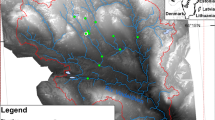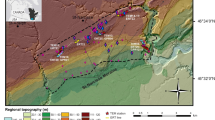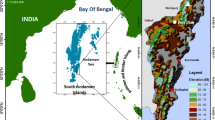Abstract
An integrated interpretation of field experimental cross-hole radar, tracer, and hydraulic data demonstrates the value of combining time-lapse geophysical monitoring with conventional hydrologic measurements for improved characterization of a fractured-rock aquifer. Time-lapse difference-attenuation radar tomography was conducted during saline tracer experiments at the US Geological Survey Fractured Rock Hydrology Research Site near Mirror Lake, Grafton County, New Hampshire, USA. The presence of electrically conductive saline tracer effectively illuminates permeable fractures or pathways for geophysical imaging. The geophysical results guide the construction of three-dimensional numerical models of ground-water flow and solute transport. In an effort to explore alternative explanations for the tracer and tomographic data, a suite of conceptual models involving heterogeneous hydraulic conductivity fields and rate-limited mass transfer are considered. Calibration data include tracer concentrations, the arrival time of peak concentration at the outlet, and steady-state hydraulic head. Results from the coupled inversion procedure suggest that much of the tracer mass migrated outside the three tomographic image planes, and that solute is likely transported by two pathways through the system. This work provides basic and site-specific insights into the control of permeability heterogeneity on ground-water flow and solute transport in fractured rock.
Resumen
Una interpretación integrada de radar experimental de campo transversal a pozos, trazadores, y datos hidráulicos demuestra el valor de combinar el monitoreo geofísico realizado en periodos de tiempo con mediciones hidrológicas convencionales en la caracterización mejorada de un acuífero rocoso fracturado. Se llevó a cabo tomografía de radar por periodos de tiempo y diferencia de atenuación durante un experimento con trazadores salinos en el sitio de investigación hidrológica de roca fracturada del Servicio Geológico de Estados Unidos cerca del Lago Espejo, Condado Grafton, New Hampshire, USA. La presencia del trazador salino eléctricamente conductivo refleja efectivamente fracturas permeables o trayectorias para imágenes geofísicas. Los resultados geofísicos orientan la construcción de modelos numéricos tri-dimensionales de flujo de agua subterránea y transporte de solutos. En un esfuerzo por explorar explicaciones alternativas para los datos tomográficos y trazadores se considera un conjunto de modelos conceptuales que involucran campos de conductividad hidráulica heterogéneos y transferencias de masa de ritmo limitado. La calibración de datos incluye concentraciones de trazadores, el tiempo de llegada de la concentración pico en la salida, y presión hidráulica en régimen permanente. Los resultados del procedimiento de acoplamiento invertido sugieren que mucho de la masa del trazador migró fuera de los tres planos de imagen tomográfica, y que el soluto es probablemente transportado por dos trayectorias a través del sistema. Este trabajo aporta ideas básicas y específicas del sitio en relación con el control de la heterogeneidad de permeabilidades en el flujo de agua subterránea y transporte de solutos en rocas fracturadas.
Résumé
Une interprétation intégrée d’études de terrain (radar entre puits, traçages, données hydrauliques) démontre la valeur de la combinaison entre la géophysique des temps finis et les mesures hydrologiques conventionnelles pour une interprétation améliorée d’un aquifère de roche fracturée. La tomographie au radar a été mise en œuvre durant un traçage artificiel au sel au site de recherche sur l’hydrologie des roches fracturées du Service Géologique des US, à proximité du Lac Mirror, Conté de Grafton, Nouvel Hampshire, USA. La présence du traceur électriquement conducteur met en relief, grâce à la géophysique, la présence de fractures ou d’écoulements préférentiels. Les résultats de la géophysique ont permis la construction de modèle hydrogéologique tri-dimensionnel des écoulements et du transport de soluté. Dans l’optique d’explorer des interprétations alternatives des données de traçage et de tomographie, différents modèles conceptuels sont utilisés concernant l’hétérogénéité des conductivités hydrauliques et des taux limités de transferts de solutés. Les données du calibrage incluent les données de concentration du traceur, le temps d’arrivée du pic de restitution et les données piézométriques en régime permanent. Les résultats de la procédure d’inversion couplée suggèrent qu’une quantité très importante du traceur migre au delà de la fenêtre de visualisation des tomographies, et que le soluté est transporté via deux voies d’écoulement préférentiel. Ce travail apporte des connaissances de base et spécifiques au site concernant la distribution de la perméabilité dans l’aquifère et le transport de soluté dans les roches fracturées.









Similar content being viewed by others
References
Archie GE (1942) The electrical resistivity log as an aid in determining some reservoir characteristics. Trans Am Inst Mineral Metall Petrol Eng 146:54–62
Becker MW, Shapiro AM (2000) Tracer transport in fractured crystalline rock: evidence of non-diffusive breakthrough tailing. Water Resour Res 36:1677–1886
Becker MW, Shapiro AM (2003) Interpreting tracer breakthrough tailing from different forced-gradient tracer experiment configurations in fractured bedrock. Water Resour Res 39:1024, Doi:10.1029/2001WR001190
Bellin A, Valocchi A, Rinaldo A (1991) Double peak formation in reactive solute transport in one-dimensional heterogeneous porous columns. Quaderni del dipartimento IDR, Dipartimento di Ingegrneria Civile ed Ambientale, Universita degli Studi di Trento
Binley A, Henry-Poulter S, Shaw B (1996) Examination of solute transport in an undisturbed soil column using electrical resistance tomography. Water Resour Res 32:763–769
Binley A, Winship P, Middleton R, Pokar M, West J (2001) High resolution characterization of vadose zone dynamics using cross-borehole radar. Water Resour Res 37:2639–2652
Day-Lewis FD, Lane JW Jr (2004) Assessing the resolution-dependent utility of tomograms for geostatistics. Geophys Res Lett 31:L07503, Doi: 10.1029/2004GL019617
Day-Lewis FD, Hsieh PA, Gorelick SM (2000) Identifying fracture-zone geometry using simulated annealing and hydraulic-connection data. Water Resour Res 36:1701–1721
Day-Lewis FD, Harris JM, Gorelick SM (2002) Time-lapse inversion of crosswell radar data. Geophysics 67:1740–1752
Day-Lewis FD, Lane JW Jr, Harris JM, Gorelick SM (2003) Time-lapse imaging of saline-tracer transport in fractured rock using difference-attenuation radar tomography. Water Resour Res 39:1290 Doi: 10.1029/2002WR001722
Dines KA, Lytle RJ (1979) Computerized geophysical tomography. Proc. Inst Electrical Electronics Eng 67:1065–1073
Ellefsen KJ, Hsieh PA, Shapiro AM (2002) Crosswell seismic investigation of hydraulically conductive, fractured bedrock near Mirror Lake, New Hampshire. J Appl Geophys 50:299–317
Gailey RM, Gorelick SM, Crowe AS (1991) Coupled process parameter estimation and prediction uncertainty using hydraulic head and concentration data. Advance Water Resour 14:301–314
Gandhi RK, Hopkins GD, Goltz MN, Gorelick SM, McCarty PL (2002) Fullscale demonstration of in-situ cometabolic biodegradation of trichloroethylene in groundwater, 1: dynamics of a recirculating well system. Water Resour Res 38:9-1–9-6
Harvey CF, Gorelick SM (1995) Temporal moment-generating equations: modeling transport and mass transfer in heterogeneous aquifers. Water Resour Res 31:1895–1911
Harvey CF, Gorelick SM (2000) Rate-limited mass transfer or macrodispersion; which dominates plume evolution at the macrodispersion experiment (MADE) site? Water Resour Res 36:637–650
Hsieh PA, Shapiro AM (1996) Hydraulic characteristics of fractured bedrock underlying the FSE well field at the Mirror Lake Site, Grafton County, New Hampshire. In: Morganwalp DW, Aronson DA (eds) US Geological Survey Toxic Substances Hydrology Program: Proceedings of the technical meeting, Colorado Springs, Colorado, 20–24 September 1993. US Geol Surv Water-Resour Invest Rept 94-4015, vol 1:127–130
Hsieh PA, Shapiro AM, Tiedeman CR (1999) Computer simulation of fluid flow in fractured rocks at the Mirror Lake FSE well field. In: Morganwalp DW, Buxton HT (eds) US Geological Survey Toxic Substances Hydrology Program: Proceedings of the Technical Meeting, Charleston, South Carolina, 8–12 March 1999, Subsurface Contamination from Point Sources. US Geol Surv Water-Resour Invest Rept 99-4018C, pp 777–781
Hubbard S, Chen J, Peterson J, Majer E, Williams K, Swift D, Mailliox B, Rubin Y (2001) Hydrogeological characterization of the DOE bacterial transport site in Oyster Virginia using geophysical data. Water Resour Res 37:2431–2456
Kitanidis PK (1995) Quasi-linear geostatistical theory for inversing. Water Resour Res 31:2411–2419
Lane JW Jr, Haeni FP, Day-Lewis FD (1998) Use of time-lapse attenuation-difference radar tomography methods to monitor saline tracer transport in fractured crystalline bedrock, In: Seventh International Conference on Ground Penetrating Radar, Lawrence, KS, 27–30 May, pp 533–538
Lane JW Jr, Day-Lewis FD, Harris JM, Haeni FP, Gorelick SM (2000) Attenuation-difference radar tomography: results of a multiple-plane experiment at the US Geological Survey fractured rock research site, Mirror Lake, New Hampshire. In: Noon DA, Stickely GF, Longstaff D (eds) Eighth International Conference on Ground Penetrating Radar, SPIE vol 4084
Menke W (1989) Geophysical data analysis: discrete inverse theory, revised edn. Academic Press, San Diego
National Research Council (1996) Rock fractures and fluid flow. Natl Acad Press, Washington, DC
Nolet G (1987) Seismic tomography. D. Reidel Publishing, Dordrecht
Olsson O, Anderson P, Gustafsson E (1991) Site characterization and validation: -monitoring of saline tracer transport by borehole radar measurements, final report, Stripa project TR91-18, Swedish Nuclear Fuel and Waste Management Co., Stockholm
Olsson O, Falk L, Forslund O, Lundmark L, Sandberg E (1992) Borehole radar applied to the characterization of hydraulically conductive fracture zones in crystalline rock. Geophys Prospect 40:109–142
Poeter EP, Hill MC (1998) Documentation of UCODE, a computer code for universal inverse modeling. US Geol Surv Water-Resour Invest Rept 98-4080
Rama Rao BS, LaVenue AM, de Marsily G, Marietta MG (1995) Pilot point methodology for automated calibration of an ensemble of conditionally simulated transmissivity fields. Water Resour Res 31:475–493
Schuster GT (1996) Resolution limits for crosswell migration and traveltime tomography. Geophys J Int 127:427–440
Shapiro A (1996) Estimation of effective porosity in fractured crystalline rock by controlled tracer tests. Joint US geological survey. US Nuclear Regulatory Commission Workshop on Research Related to Low-level Radioactive Waste Disposal, pp 185–190
Shapiro A (2001) Effective matrix diffusion in kilometer-scale transport in fractured crystalline rock. Water Resour Res 37:507–522
Slater L, Binley AM, Daily W, Johnson R (2000) Cross-hole electrical imaging of a controlled saline tracer injection. J Appl Geophys 44:85–102
Tiedeman CR, Hsieh PA (2001) Assessing an open-well aquifer test in fractured crystalline rock. Ground Water 39:68–78
Tiedeman CR, Goode DJ, Hsieh PA (1998) Characterizing a ground water basin in a New England mountain and valley terrain. Ground Water 36:611–620
Tsang YW, Tsang CF (1989) Flow channeling in a single fracture as a two-dimensional strongly heterogeneous permeable medium. Water Resour Res 25:2076–2080
Vasco DW, Datta-Gupta A, Long JCS (1997) Resolution and uncertainty in hydrologic characterization. Water Resour Res 33:379–397
Wagner BJ (1992) Simultaneous parameter estimation and contaminant source characterization for coupled groundwater flow and contaminant transport modelling, J Hydrol 35:275–303
Wagner BJ, Gorelick SM (1989) Reliable aquifer remediation in the presence of spatially-variable hydraulic conductivity: from data to design. Water Resour Res 25:2211–2225
Wen Xian-Huan, Gomez-Hernandez J, Capilla JE, Sahuquillo A (1996) Significance of conditioning to piezometric head data for predictions of mass transport in groundwater modeling. Math Geol 28:951–968
Acknowledgments
This material is based upon work supported by the National Science Foundation under Grant Nos. EAR-0124262 and EAR-9705812. Any opinions, findings, and conclusions or recommendations expressed in this material are those of the author(s) and do not necessarily reflect the views of the National Science Foundation. Additional support was provided by the US Geological Survey Toxic Substances Hydrology Program and the US Environmental Protection Agency through EPA STAR Fellowship U-915155-01-0.
Author information
Authors and Affiliations
Corresponding author
Rights and permissions
About this article
Cite this article
Day-Lewis, F.D., Lane, J.W. & Gorelick, S.M. Combined interpretation of radar, hydraulic, and tracer data from a fractured-rock aquifer near Mirror Lake, New Hampshire, USA. Hydrogeol J 14, 1–14 (2006). https://doi.org/10.1007/s10040-004-0372-y
Received:
Accepted:
Published:
Issue Date:
DOI: https://doi.org/10.1007/s10040-004-0372-y




